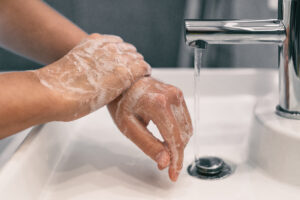During my annual holiday baking, I often mix up a batch of homemade “Playdoh” for my child to feel a part of things. Since it doesn’t have raw eggs, it should be safe, right?
The short answer: No!
The explanation: It’s become fairly common knowledge that raw eggs can carry Salmonella and cause food poisoning, but did you know that flour can also contain bacteria that cause disease? Only the introduction of a “kill step” (e.g., boiling, baking, roasting, microwaving, frying) will kill the bacteria for safe consumption.
This means that even if you are making a dough that does not contain eggs, tasting the dough prior to baking can cause serious illness. In one such outbreak, dozens of people across the U.S. were sickened by E. coli with which the flour was found to be contaminated. The FDA investigation also found that some of the subsequently recalled flour had been used in “doh” that restaurants provided to children to play with while waiting for their meals.
Even if children do not eat the ’doh they are playing with (from a restaurant, daycare, or your home) or the dough with which they are helping to make cookies or other goodies, just putting a hand to their mouth after handling it can cause food poisoning. And Shiga Toxin Producing E. coli (STEC), which is a significant concern in flour, can be particularly harmful. Symptoms, which may appear immediately or up to two weeks later, can include diarrhea (sometimes bloody), stomach cramps, fever, and occasionally hemolytic uremic syndrome (HUS), which can lead to kidney failure and even death – with the risk of HUS highest in children under 5.
Flour is derived from grain that comes directly from the field, with no feasible kill step before it is milled into flour. In fact, a study’s finding that 10% to 30% of tested flour samples contained E. coli clearly illustrates the dangers of raw flour and the importance of cooking.





